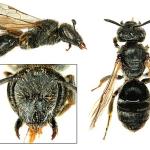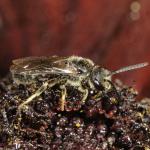A very similar bee to the closely related Lasioglossum quadrinotatum (Kirby); the two species are best distinguished by characters of the male genitalia.
Widespread in southern Britain, being found from the Isles of Scilly to East Kent and north to Yorkshire and in Wales but not in Scotland or the Isle of Man. It is known from the Channel Islands but only from Jersey. Recorded from Ireland in O’Connor et al. (2009).
Abroad, a western Palaearctic species, found from Western Europe east to Iran, north to southern Sweden and south to Iberia and Crete; accidentally introduced into the Azores (A W Ebmer, pers. comm.).
This species is not regarded as scarce or threatened.
A woodland edge species, sometimes found in gardens in southern Britain, also from grasslands, ruderal habitats and orchards.
Probably univoltine. The female flies from early March to late October; the male, from mid July to mid October.
Believed to be a solitary mining bee but the nesting behaviour is apparently unrecorded.
Flower visits are mainly to Asteraceae, including dandelions, but other families are also used, including Rosaceae, Ranunculaceae, Salicaceae and Ericaceae.
The cleptoparasitic bees Sphecodes ephippius (Linnaeus) and Sphecodes puncticeps Thomson are reputed to parasitise this bee.
2016



